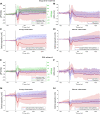Capturing postural blood pressure dynamics with near-infrared spectroscopy-measured cerebral oxygenation
- PMID: 37041313
- PMCID: PMC10651596
- DOI: 10.1007/s11357-023-00791-9
Capturing postural blood pressure dynamics with near-infrared spectroscopy-measured cerebral oxygenation
Erratum in
-
Correction to: Capturing postural blood pressure dynamics with near‑infrared spectroscopy‑measured cerebral oxygenation.Geroscience. 2023 Oct;45(5):3095-3096. doi: 10.1007/s11357-023-00837-y. Geroscience. 2023. PMID: 37256520 Free PMC article. No abstract available.
Abstract
Orthostatic hypotension (OH) is highly prevalent in older adults and associated with dizziness, falls, lower physical and cognitive function, cardiovascular disease, and mortality. OH is currently diagnosed in a clinical setting with single-time point cuff measurements. Continuous blood pressure (BP) devices can measure OH dynamics but cannot be used for daily life monitoring. Near-infrared spectroscopy (NIRS) has potential diagnostic value in measuring cerebral oxygenation continuously over a longer time period, but this needs further validation. This study aimed to compare NIRS-measured (cerebral) oxygenation with continuous BP and transcranial Doppler-measured cerebral blood velocity (CBv) during postural changes. This cross-sectional study included 41 participants between 20 and 88 years old. BP, CBv, and cerebral (long channels) and superficial (short channels) oxygenated hemoglobin (O2Hb) were measured continuously during various postural changes. Pearson correlations between BP, CBv, and O2Hb were calculated over curves and specific characteristics (maximum drop amplitude and recovery). BP and O2Hb only showed good curve-based correlations (0.58-0.75) in the initial 30 s after standing up. Early (30-40 s) and 1-min BP recovery associated significantly with O2Hb, but no consistent associations were found for maximum drop amplitude and late (60-175 s) recovery values. Associations between CBv and O2Hb were poor, but stronger for long-channel than short-channel measurements. BP associated well with NIRS-measured O2Hb in the first 30 s after postural change. Stronger associations for CBv with long-channel O2Hb suggest that long-channel NIRS specifically reflects cerebral blood flow during postural transitions, necessary to better understand the consequences of OH such as intolerance symptoms.
Keywords: Aging; Blood pressure; Cerebral oxygenation; Near-infrared spectroscopy; Orthostatic hypotension.
© 2023. The Author(s).
Conflict of interest statement
Marianne Floor-Westerdijk and Mathijs Bronkhorst are employees of Artinis Medical Systems and were involved in the development of the NIRS device used in this study. This research was part of a funded project in which Artinis Medical Systems (the manufacturer of the NIRS system) also participated. The authors declare no other competing interests.
Figures


Similar articles
-
Dynamic Alterations in Cerebral Hemodynamics Measured by Portable Near-Infrared Spectroscopy in Orthostatic Hypotension and Intolerance.Am J Hypertens. 2023 Jun 15;36(7):385-393. doi: 10.1093/ajh/hpad025. Am J Hypertens. 2023. PMID: 36905205
-
Sensitivity and reliability of cerebral oxygenation responses to postural changes measured with near-infrared spectroscopy.Eur J Appl Physiol. 2019 May;119(5):1117-1125. doi: 10.1007/s00421-019-04101-0. Epub 2019 Feb 15. Eur J Appl Physiol. 2019. PMID: 30771059 Free PMC article.
-
Reproducibility of orthostatic changes in cerebral oxygenation in healthy subjects aged 70 years or older.Clin Physiol. 2001 Jan;21(1):77-84. doi: 10.1046/j.1365-2281.2001.00290.x. Clin Physiol. 2001. PMID: 11168300
-
Determinants of orthostatic cerebral oxygenation assessed using near-infrared spectroscopy.Auton Neurosci. 2022 Mar;238:102942. doi: 10.1016/j.autneu.2022.102942. Epub 2022 Jan 20. Auton Neurosci. 2022. PMID: 35124323 Review.
-
Cerebral Oximetry in Syncope and Syndromes of Orthostatic Intolerance.Front Cardiovasc Med. 2019 Nov 22;6:171. doi: 10.3389/fcvm.2019.00171. eCollection 2019. Front Cardiovasc Med. 2019. PMID: 31824964 Free PMC article. Review.
Cited by
-
Home-based monitoring of cerebral oxygenation in response to postural changes using near-infrared spectroscopy.Geroscience. 2024 Dec;46(6):6331-6346. doi: 10.1007/s11357-024-01241-w. Epub 2024 Jun 18. Geroscience. 2024. PMID: 38890204 Free PMC article.
-
The application of infrared thermography technology in flap: A perspective from bibliometric and visual analysis.Int Wound J. 2023 Dec;20(10):4308-4327. doi: 10.1111/iwj.14333. Epub 2023 Aug 8. Int Wound J. 2023. PMID: 37551726 Free PMC article.
-
Preoperative physical resilience indicators and their associations with postoperative outcomes.Geroscience. 2025 Jun;47(3):4857-4870. doi: 10.1007/s11357-025-01633-6. Epub 2025 Apr 2. Geroscience. 2025. PMID: 40175848 Free PMC article.
References
Publication types
MeSH terms
Substances
Grants and funding
LinkOut - more resources
Full Text Sources

